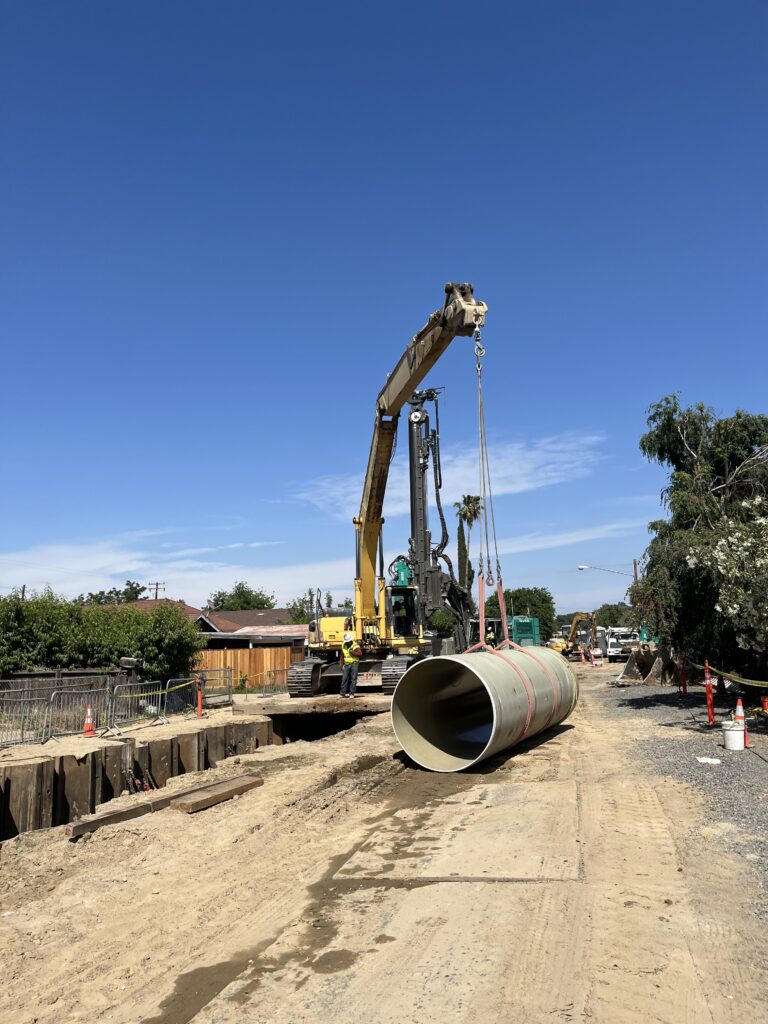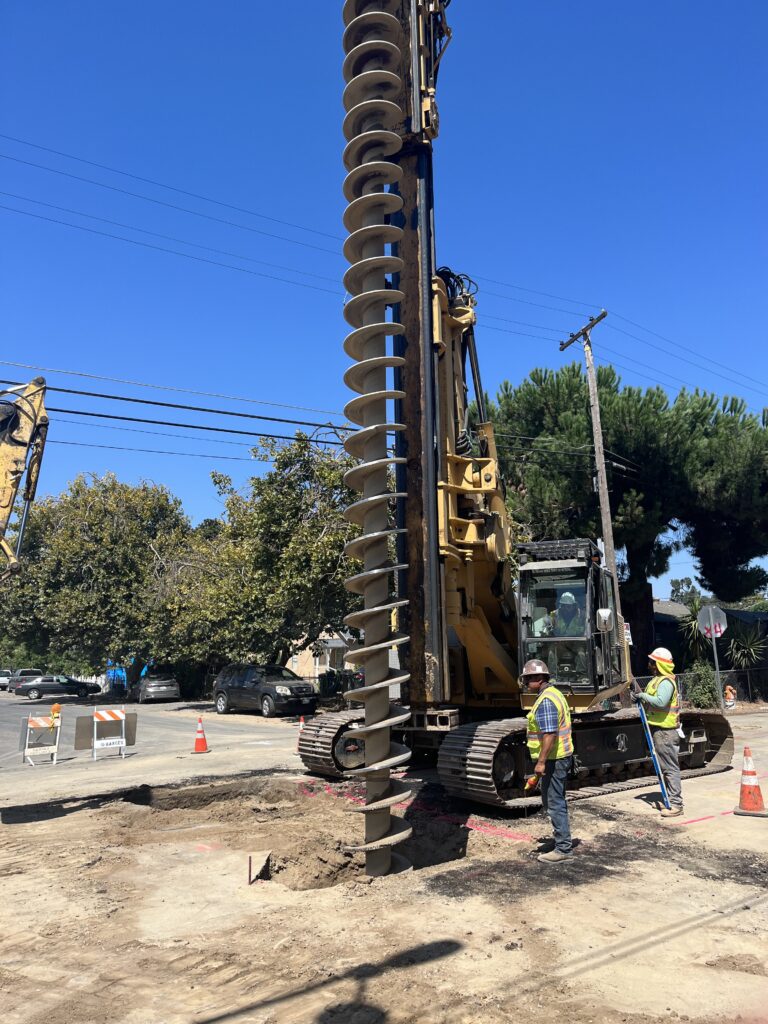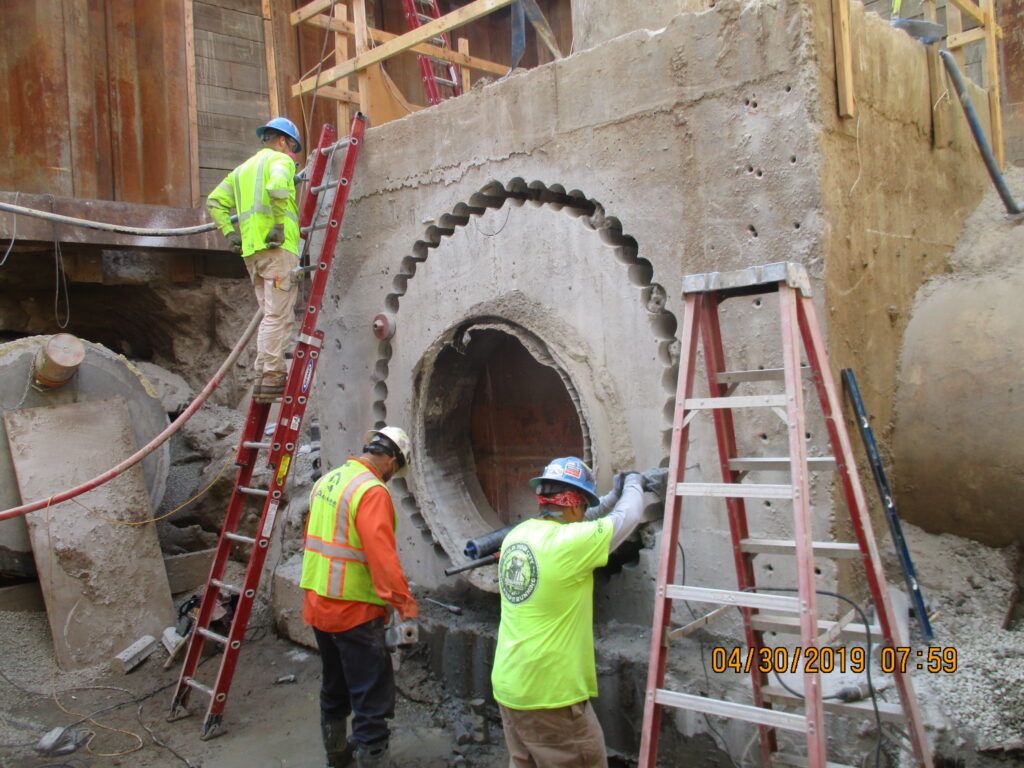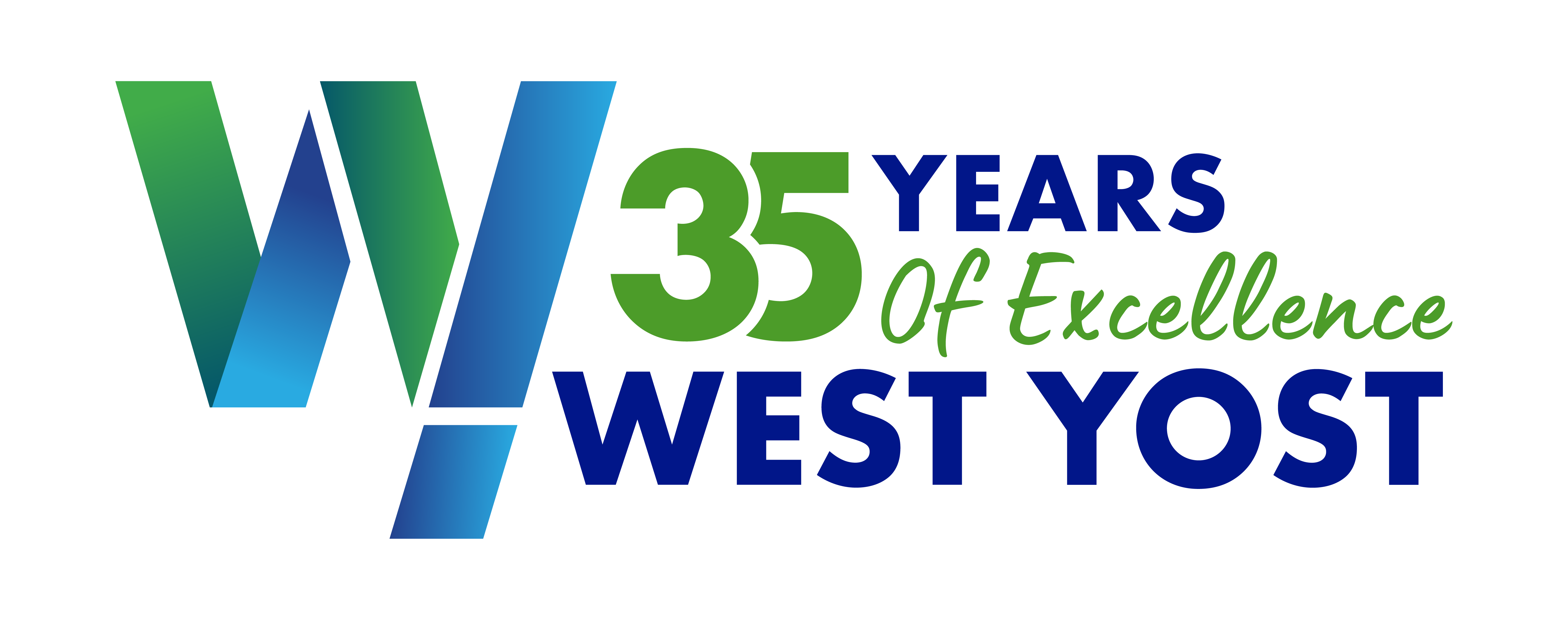The Art of Construction Management

By Ted Doty, Construction Manager
This article contains and answers the following:
- West Yost’s Role: serves as Construction Managers to projects
- Experience is Key: How experience shapes allows you to be a better leader
- Pros and Cons: The advantages and set backs to adding a new role.
- Roles and Responsibilities: Construction Manager, Owner, Design Engineer, Contractor, Community, General Safety
How did construction management come about?
Key role and responsibilities a construction team?
What are the advantages and disadvantages of construction management?
What makes a good construction manager?
Back in the 80’s the construction industry really struggled finding quality personnel to run their projects. Companies would hire graduating engineers that were very smart and good at calculating forces, but it took a lot of time and effort to train them in what is needed to bring in a successful project. Because of this need, colleges started developing construction management programs that could teach students the processes that were required. As the programs developed, they also realized that this new discipline could help owners in dealing with the construction process and could be the buffer between the parties which created the birth of the Construction Manager (CM).

The new role of CM seemed like a great idea and as the industry started realizing the benefits of this new position, it also realized the problems of the two business models. The Contractor’s approach to running a successful business is based on speed and efficiency, whereas the CM’s inherent value to the owner is based on delivering the project with the highest level of quality, while adhering to the constraints of time and budget. This conflict of interests is where the crux of contention is usually manifested, which has led to many adjustments throughout the years to help all parties involved achieve the common goal of a successful completion, but with unintended consequences. The specification books got longer, and submittal requirements became more stringent. Interaction between the contractor and the CM became difficult at times as contractors felt the CM was relying too heavily on the plans and specifications without factoring in real world conditions and contractor inquiries, and negotiations were directed to the CM as opposed to directly with the owner as they had in the past. As a result, construction costs increased to offset lost profits that were once realized through efficiencies balanced by enforcement of higher quality by the CM, and contractors started pushing for progressive design bid build projects to get a seat at the table again.
“The key to embodying the Art of Construction Management is realizing both positive and constructive feedback is a gift.”
Over the years, the relationship between the contractor and CM has improved, but a lot of this is dependent on the experience of the personnel involved in the project. If you have someone who is new, the tendency is to rely exclusively on the plans and specifications due to lack of experience. Unfortunately, no one can write a specification that covers all situations. For this reason, one must use what we call the Art of Construction Management.

For a project team to realize the benefits of embracing the Art of Construction Management, it begins by understanding how a project comes together in today’s design-bid-build (DBB) market. The Design Engineer can take about 9-12 months to evaluate an issue and design a solution. The specifications are usually pulled from past projects and should be fully vetted, but often are not before they go out to bid. The contractor is usually given about 4-6 weeks (about one and a half months) to review, interpret, takeoff, price, and produce a game plan to build the project. Once the project is awarded, the CM is brought in to work with the contractor to complete the project. This process has worked for many years, but it is not always the most efficient. To help this process, many owners are starting to hire the CM early in the process to perform constructability reviews before the bid documents are published.
As a CM, it is important to understand there is inherent bias in our day-to-day approach because our performance hinges upon high quality and keeping costs low. While this is true, it is also important to understand that the approach and philosophy of overseeing the project to completion should be framed, not by what benefits any one of the project stakeholders’ interests, but by what needs to be done in the best interest of the project. Some CMs take the approach that they are there to watch the contractor and enforce the contract. They feel that it is the contractor’s “means & methods”, and they are there to observe and not direct the path of the project. While this approach may reduce the liability of the CM, it also greatly impacts the success of the project as it usually leads to mistakes, inefficiencies, delays, change orders or claims that could be avoided with more hands-on involvement by all project team members to the full extent of their capabilities.

The Art of Construction Management calls on the entire project team to work together as a unit, and the CM should take the lead role in this endeavor. The CM is not hired to be a security guard or firefighter. We should not wait until there is an issue and then respond. We should take ownership of the project by proactively getting ahead of potential issues based on our years of experience and drive it to success.
Click on the titles below to learn about how this role contributes to the success of a project and the art of construction management.
The Construction Manager
The CM’s main role is to act as the city’s principal agent in managing the city’s project. It is our responsibility to manage the preconstruction, construction, and post-construction phases. The CM also represents the interests of the city in dealing with other construction professionals and with private and public entities. The CM must be professional and possess inclusive leadership and facilitation skills that draw out the contributions of the individuals on the project team including the city’s staff, design consultant(s), Genral Contractor (GC), key subcontractors, and in some cases external stakeholders that have a vested interest in the project. The CM must be part accountant, part attorney, part designer, and part psychologist. To make a project successful, the CM must evaluate all aspects of the project.
The Owner
As the owner’s representative, the CM’s main focus is to help the owner through the construction process. Some owners are knowledgeable while others can struggle with understanding what is involved. Some owners have a “hands-off” attitude while others want to be involved in every decision, which will dictate how the CM should approach the project. It is recommended that the CM spend the time needed to really get to know the owner and the end users of the finished product to make sure that what is being built, meets their needs. By doing this evaluation early in the process, changes can be made at a reduced cost instead of costly re-work or the end users having to live with something they are not happy with. It is also the CM’s responsibility to look out for the best interest of the owner. Most of the time this involves minimizing the cost or ensuring the quality of the finished product but there are times that the CM needs to educate the owner on the risk of some of their decisions. I have seen owners “dig in” on a certain position that would end up in arbitration, if not for the relationship building and trust that a seasoned CM should establish at the beginning of projects that helps to ease the sting of a difficult conversation.
The Design Engineer
The design engineer’s main responsibility is to evaluate the needs of the owner and produce a design to meet those needs. The focus is usually on a process or a certain problem that needs to be resolved. This process is difficult and there is so much information that must be pulled together that many times the constructability or the end user’s convenience can be overlooked. But when trying to coordinate and assemble that much information, no one is going to catch everything. It is the CM’s responsibility to evaluate the plans and specifications for potential issues from a contractor’s perspective before the contractor bids on and is ready to perform the work. End-user accessibility and maintenance requirements can affect the finished product. By having these conversations early, you can reduce the amount of change orders or claims to the project.
The Contractor
The contractor’s focus is how to safely build the project on time and under budget. The coordination process for success is difficult. There are so many moving parts that sometimes, “they can barely see the forest for the trees.” As the CM, it is our responsibility to help the contractor be successful in this endeavor. One of the key factors to a successful project is helping the contractor to be successful without sacrificing quality. Looking ahead and clearing the roadblocks for them helps eliminate items being missed or installed incorrectly, which leads to poor quality of the installation, re-work, and possible claims. The CM must also remember that in a competitive DBB low bid award market, the low bidder is taking the most financial risk to secure the project award. Most of the time the second or third bidder’s’ price is closer to the actual market value of the project. With these tight budgets, the contractor must be as efficient as possible. If they feel that the owner/CM is not working with them, then this could lead to animosity where crews will start to cut corners or have the attitude of installing it per plan where errors are evident but were not efficiently addressed before being installed, which leads to missed opportunities to improve the quality of the project. It is the CM’s responsibility to evaluate the contractor’s strengths and weaknesses and work to help them in the areas they are struggling to bring in a successful project.
The Community
Most construction projects have a significant impact on the community around them. Lane and road closures, detours, traffic delays, ingress/egress, etc. can be a huge inconvenience to the residents and business around a project. These closures also affect schools, bus routes, garbage collection, utility services, and emergency response. Public outreach to the community, led by the CM, is vital to the project’s success. Many times, this will involve walking door-to-door in the immediate vicinity to identify the project team and notify residents and neighborhood businesses of the work that will be performed in the area. This information usually includes the reason for the project, how long it will take, and establish lines of communication for their voices to be heard. This early and continued notification to the public can reduce the impact on the community.
General Safety
At the end of the day, the most important part of a CM job is to make sure everyone goes home to their families. Construction is a dangerous business with a lot of moving parts that could cause injury or even be fatal. The pressure of getting the job done as quickly as possible to maximize profits can cause some employees to disregard safety procedures that they feel are impacting productivity or not necessary. On average, there are more than 200,000 injuries and over 1,000 fatalities a year in the United States. One of the number one goals in the Art of Construction Management is to communicate the importance of everyone going home safely and educate the crews when we see something that could be dangerous, while delivering the project with high quality and efficiency. In the end, we are all part of a big construction family, and we need to work together to make sure everyone is safe.
“Unfortunately, no one can write a specification that covers all situations. For this reason, one must use what we call the Art of Construction Management. “
The key to embodying the Art of Construction Management is realizing both positive and constructive feedback is a gift; construction management is a never-ending learning process in forward thinking, pre-planning, communication, using lessons-learned, and the understanding that everyone is working hard to make their portion of the project a success. As the leader of this process, it can be difficult for the CM to balance the interests of all parties involved. If the CM entrusted to lead a project team is fair, honest in their decisions, is inclusive, transparent, and responsive with the other project stakeholders, and does what is in the best interest of the project, it will go a long way in building the relationships needed to achieve a successful project.
By Ted Doty, Construction Manager
Ted Doty has extensive experience in construction management, general contracting, and construction inspection, he has successfully overseen industrial, water, and wastewater infrastructure projects, including design-build ventures up to $70 million. Specializing in water and wastewater infrastructure, Ted has managed projects involving pretreatment and filtration structures, digesters, aeration systems, and large-diameter underground piping. His roles have encompassed project bidding, constructability review, contract negotiations, and comprehensive project tracking and documentation.
